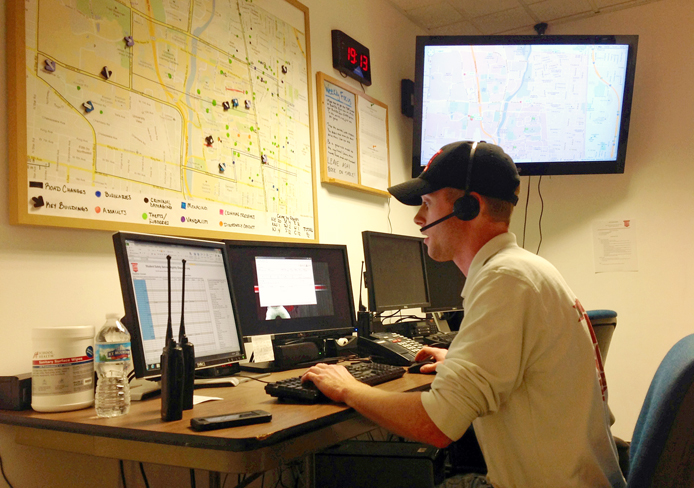
A Student Safety and Escort Service employee dispatches cars. The program installed new GPS units for Fall Semester.
Credit: Aubrey Sinclair / For The Lantern
An Ohio State transportation program took a step toward improving its service this semester with the installation of GPS units.
Student Safety Service is funded by University Police to provide transportation during the evening and early morning for OSU students, faculty and staff in the campus area, according to its website. The service made the change over the summer to increase the number of students it can give rides to and the rate at which it can pick students up with its escort service.
The units cost about $175 per month to run, Sean Bolender, program coordinator for Student Safety and Escort Services, said in an email.
Student Safety and Escort Service has seven cars, but typically only uses three to six on the road on any given night, Bolender said on the phone.
Bolender said with the GPS, dispatchers can track where a vehicle is so the drivers can pick up more students than were originally scheduled.
If a student who needs a ride is located near an already dispatched car, the dispatcher can contact that car to pick them up if there is enough time before other previously scheduled rides. Drivers had to adhere to a stricter schedule before this technology was added because the dispatcher couldn’t see if there were cars near last-minute callers, Bolender said.
He said in an email, though, there are no definite numbers on how many more riders the service can pick up now because there isn’t much data at this point.
“This is the first Fall Semester where we have a heavier demand where we get to see how it works out and so far, we’ve gotten good feedback from our dispatchers,” Bolender said.
Complaints had circulated that the service booked up too quickly and students were denied a ride or the vehicle would show up late, Bolender said, but adding the new GPS units was a step toward cutting down on those problems.
Some students said they think the service could benefit from investing in more cars.
“Sometimes (it’s) just not practical to call if it’s going to be a two hour wait,” said Erin Kaminski, a third-year in public affairs who has used Student Safety before. “It’s just easier to walk home. So I think that’s the biggest thing is just not having enough vehicles available for students.”
Kaminski said the GPS units sound like a step in the right direction.
“That would be very helpful to navigate around campus and to help them to go (pick up students) quicker,” Kaminski said.
Other students have had problems getting rides from Student Safety in the past as well.
“It was just hard to get appointments on really busy nights,” said Molly Wiberg, a fourth-year in health science.
Although the new technology was implemented to help open up more opportunities for rides, students are still being urged to call ahead and schedule their ride if they need a specific time.
“We’re excited for the new school year, especially with the GPS system, so we’re looking forward to seeing if we can continue to chip away at that decline rate to get less complaints,” Bolender said.
Over the last few years, the program has made several other “zero cost” improvements, Bolender said in an email, including refining its internal training and restructuring its mentorship program.
This article has been revised to reflect the following correction:
Correction: Sept. 22, 2013
An earlier version of this article mistakenly referred to a program as the Student Safety and Escort Service, when in fact, the program is the Student Safety Service. It identified the program as a transportation program, when in fact, Student Safety Service is a public safety program that reports criminal activity as well as providing rides for students.


